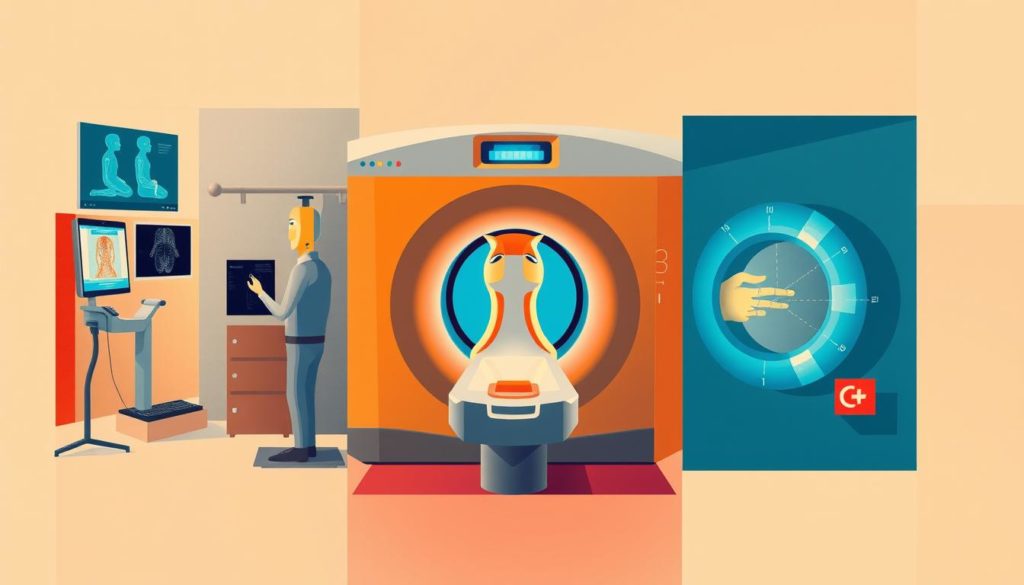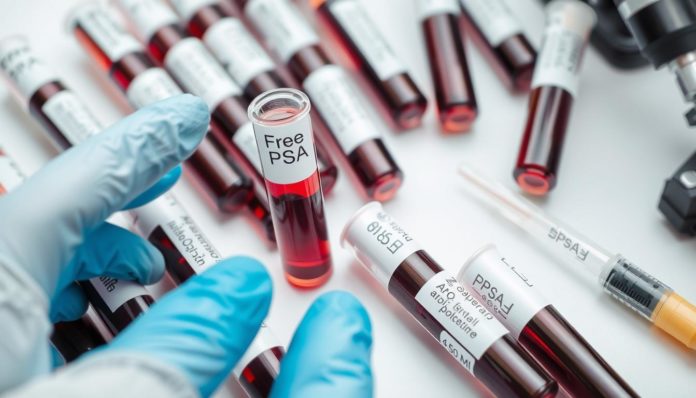For men, knowing the risk of prostate cancer is key, especially as they get older. A key test in this is the free PSA blood test. This test looks at PSA, a protein made by the prostate. But it focuses on free PSA, which is not attached to other proteins in the blood.
Doctors often use the free PSA blood test in prostate cancer screenings. A low free-to-total PSA ratio might mean a higher risk of cancer. It’s important for men to talk about their screenings with their doctors often.
Even a low free PSA doesn’t always mean cancer is present. Many things can affect PSA levels, like age, race, weight, and lifestyle. Following screening guidelines helps understand PSA levels better and their meaning.
What is PSA and Its Role in Prostate Cancer Screening?
PSA, or prostate-specific antigen, is key in fighting prostate cancer. It’s a protein made by the prostate gland. The level of PSA in blood is measured in nanograms per milliliter (ng/mL). It’s vital for catching prostate cancer early.

PSA Definition
PSA is a protein made by both healthy and cancerous prostate cells. A PSA test checks how much of this protein is in your blood. High levels might mean cancer, but they can also mean other issues like an enlarged prostate or infection.
PSA Test Procedure
To get a PSA test, blood is taken from your arm. Then, a lab checks how much PSA is in the blood. This process is simple, but waiting for the results can take a few days. It’s important to know what normal and abnormal PSA levels mean.
Normal vs. Abnormal PSA Levels
PSA levels under 4 ng/mL are usually okay. Levels between 4 and 10 ng/mL might mean cancer or another issue. But levels over 10 ng/mL often point to cancer. Remember, these numbers aren’t the final word and should be checked with other tests.
Free vs. Total PSA
It’s important to know the difference between free and total PSA for prostate cancer tests. Total PSA is all PSA in your blood, while free PSA is not bound to proteins. More free PSA usually means it’s not cancer. Knowing about both types helps understand PSA test results better.
Learning about PSA, its tests, and what the results mean helps you make smart choices about your prostate health.
How Doctors Use Free PSA Levels for Prostate Cancer Detection
Doctors rely on free PSA levels to check Prostate Cancer risk. They start by understanding how free PSA testing works.
Free PSA Testing Procedure
A free PSA test is a simple blood test. It looks at the PSA not bound to proteins in the blood. This gives doctors a clearer view. They combine it with total PSA levels for better accuracy in finding prostate cancer.

Interpreting Free PSA Results
Reading free PSA test results is key to spotting Prostate Cancer risk. Free PSA levels are compared to total PSA levels for a ratio. A low ratio often means a higher chance of cancer.
If total PSA levels are unsure but worrying, a low free PSA ratio hints at cancer.
Importance of Free PSA Ratio
The free PSA ratio is vital for doctors. It helps them decide if a biopsy or more tests are needed. This ratio is crucial when total PSA levels are unclear.
So, free PSA levels play a big part in accurately assessing Prostate Cancer risk.
Low Free PSA Prostate Cancer Risk
Understanding the Low Free PSA significance is key in prostate cancer screening. When two people have the same total PSA levels, the free PSA test can tell which one is at higher risk. The person with lower free PSA levels is more likely to have prostate cancer.
The free PSA test also helps understand how aggressive the cancer is. A low free-to-total PSA ratio might mean the cancer is more aggressive. This makes early detection and knowing the risk level very important.
Doctors must look at Low Free PSA significance along with total PSA levels and other health factors. This way, they can give a full risk assessment. This approach helps in making screening strategies for prostate cancer detection more effective and tailored to each person.
Factors Affecting PSA Levels
PSA levels can change for many reasons, making it key to get accurate tests for prostate cancer risk. Knowing what affects PSA levels helps in making a correct diagnosis.
Age and PSA Levels
The PSA levels age factor is very important for checking prostate health. As men get older, their PSA levels usually go up. Older men often have higher PSA counts. It’s vital to think about age when looking at PSA test results to avoid false alarms or wrong diagnoses.
Race and Ethnicity
The PSA levels racial impact is another big factor. Research shows that race and ethnicity can change PSA levels. For example, African American men usually have higher PSA levels than white or Asian men. This means we need to tailor screening methods based on ethnicity for accurate results.
Weight and Lifestyle
Lifestyle affecting PSA levels includes things like weight and smoking habits. Being overweight can lower PSA levels, which might hide prostate health problems. Smoking history can also lower PSA readings. It’s important to tell doctors about these lifestyle factors to get the right test results.
Medications and Supplements
Some medicines and supplements can change PSA levels too. For example, drugs for benign prostatic hyperplasia might lower PSA counts, hiding health issues. Patients should tell their doctors about all medicines and supplements they take for a correct PSA test.
| Factor | Impact on PSA Levels |
|---|---|
| Age | Higher PSA levels as age increases |
| Race | African American men tend to have higher PSA levels |
| Weight | Obesity is associated with lower PSA levels |
| Smoking | Smoking history can reduce PSA readings |
| Medications & Supplements | May lower PSA levels, especially for treating prostate conditions |
Understanding the Significance of Low Free PSA Levels
Knowing the Significance of low Free PSA levels is key to managing prostate cancer risk. Low levels often mean a higher chance of cancer, especially aggressive types. But, there are also other reasons for low PSA that are not cancer-related.
Correlation with Prostate Cancer
Low free PSA levels are often linked to a higher risk of prostate cancer. This is especially true for aggressive tumors. When free PSA goes down, the ratio of free to total PSA changes. This could mean cancer is present. So, men should talk to their doctors about the Significance of low Free PSA.
Other Causes of Low Free PSA
Prostate cancer is a big concern with low free PSA levels. But, other issues like benign prostatic hyperplasia (BPH), an enlarged prostate, and prostatitis can also cause low PSA. Knowing these causes of low Free PSA helps with accurate diagnosis and treatment plans.
Talking with healthcare experts about the Significance of low Free PSA levels is important. It helps understand all possible causes. This leads to better health care and decisions.
Prostate Cancer Risk Assessment Methods
Knowing the risk of prostate cancer is key to catching it early and managing it well. There are more ways to check for risk than just the PSA test. These methods look at family history, genes, the environment, and lifestyle choices. By understanding prostate cancer risk factors, we can see a full picture of our prostate health.
A detailed check-up for prostate health is a big part of assessing risk. This check-up is done by a healthcare provider and gives a personalized risk score. It helps decide if more tests or screenings are needed.
Here are the main things considered in this check-up:
- Family History: Having prostate cancer in your family raises your risk.
- Genetics: Certain genes and mutations mean you might be more likely to get prostate cancer.
- Environmental Influences: Being exposed to certain chemicals and toxins can up your risk.
- Lifestyle Choices: What you eat, how much you exercise, and if you smoke can change your risk.
This check-up looks at many things to give a detailed view of your risks. When combined with PSA tests and other tests, it helps decide if you need more tests or a prostate biopsy.
Here’s a quick look at the main ways to check risk:
| Assessment Method | Components | Impact on Risk Profile |
|---|---|---|
| Family History | History of prostate cancer in close relatives | Increases risk |
| Genetic Testing | Analysis of genetic markers and mutations | Identifies high-risk individuals |
| Environmental Exposure | Exposure to toxins and chemicals | Potentially increases risk |
| Lifestyle Evaluation | Diet, exercise, smoking habits | Affects overall and specific risks |
By using all these methods, doctors can make screening plans that fit you better. This helps in managing prostate cancer more effectively.
Guidelines for PSA Test Prostate Cancer Screening
Starting conversations about PSA tests is key for men at 50. If you have a family history of prostate cancer, talk about it earlier. Early screenings can save lives by catching cancer early.
When to Get Tested
Men should start PSA testing at 50. If you’re at higher risk, you might need to start sooner. This way, any cancer can be caught early and treated quickly.
Frequency of Testing
How often you need a PSA test depends on your risk and test results. If your PSA levels are high, you might need tests more often. This helps catch problems early and keep a close eye on your health.
Understanding Results and Next Steps
PSA test results need careful thought. A high PSA doesn’t always mean cancer. You might need more tests, change your lifestyle, or have a biopsy. Always talk to your doctor to understand your results and what to do next.
Prostate Cancer Detection: Beyond PSA Tests
The PSA test is a common way to check for prostate cancer, but there are other methods too. These prostate cancer detection methods give a better look at prostate health.
Digital Rectal Exam (DRE)
A key tool for finding prostate cancer is the DRE prostate exam. In this exam, a doctor feels the prostate for any unusual signs. It’s a quick check that can spot cancer signs like an enlarged or hard prostate.
Biopsy
If tests like the PSA test or DRE show cancer might be present, a biopsy is next. It takes small prostate tissue samples to look for cancer cells under a microscope. This method is key for a sure cancer diagnosis. Using PSA and biopsy together can cut down on unnecessary tests and catch aggressive cancers early.
Imaging
New prostate imaging tools like MRI and ultrasound are big improvements. They make detailed pictures of the prostate. This lets doctors see tumors and plan treatments better. Adding prostate imaging to diagnosis helps make treatment more precise, which is good for patients.
Dealing with False Positives and Negatives in PSA Testing
PSA testing can sometimes give wrong results, leading to challenges in diagnosing prostate cancer accurately. It’s crucial to understand these issues to improve screening and reduce mistakes.
Causes of False Positives
False positives happen when the test shows cancer is present but it’s not. This can be due to non-cancerous issues like prostate inflammation or BPH. Riding a bike or having sex before the test can also raise PSA levels, causing a false positive.
Causes of False Negatives
On the other hand, false negatives can make it seem like there’s no cancer when there really is. This might be because the PSA levels are low but not normal, or other things hide the true PSA level. Certain medicines or health conditions can also affect the test’s accuracy, possibly delaying a vital diagnosis.
Minimizing Errors in PSA Testing
To cut down on PSA testing mistakes, a detailed plan is needed. Doctors might suggest testing again to check the first results, especially if they’re not clear. It’s best to avoid activities that can raise PSA levels before the test, like hard exercise or sex.
Using tests like the digital rectal exam, biopsy, and advanced imaging can help make the results clearer and more accurate. This ensures a detailed and accurate check-up.
FAQ
What is PSA and its role in prostate cancer screening?
PSA stands for prostate-specific antigen. It’s a protein made by the prostate gland. Doctors use a blood test to check PSA levels during prostate cancer screenings. High PSA levels might mean cancer is present, but they can also be due to other health issues.
This test helps doctors understand prostate health and the cancer risk.
What is the significance of low free PSA levels in prostate cancer detection?
Low free PSA levels might mean a higher chance of prostate cancer, especially aggressive types. Doctors look at the free PSA compared to total PSA to make a better assessment. This helps decide if more tests, like biopsies, are needed.
How is a free PSA level test conducted?
The free PSA test is a blood test. It measures the free PSA, which is PSA not attached to proteins in your blood. This helps tell apart prostate cancer from other issues.
How do doctors interpret free PSA test results?
Doctors look at the free PSA to total PSA ratio. A lower ratio often means a higher chance of prostate cancer. This ratio, along with total PSA levels, helps decide if more tests are needed.
What factors can affect PSA levels?
Many things can change PSA levels, like age, race, weight, and lifestyle. Older people usually have higher PSA levels. Racial differences can also affect free PSA levels.
What other methods exist for assessing prostate cancer risk?
Besides PSA tests, doctors look at family history, genetics, lifestyle, and environment. This helps create a detailed risk profile. It guides further screening and tests.
What are the guidelines for PSA test prostate cancer screening?
Guidelines say talk to your doctor about PSA tests starting at 50 or earlier if you have risk factors. How often you get tested depends on your results and risk level. It’s important to understand these results for planning next steps, like more tests or biopsies.
What other prostate cancer detection methods are used beyond PSA tests?
Besides PSA tests, doctors use digital rectal exams (DRE), biopsies, and imaging like MRI and ultrasound. DRE lets doctors feel the prostate for any unusual areas. Biopsies check for cancer cells in tissue samples.
How do false positives and negatives affect PSA testing?
False positives can happen when tests show cancer isn’t really there, often due to other health issues. False negatives miss cancer when it’s there, leading to delayed diagnoses. To reduce mistakes, doctors might repeat tests, avoid certain activities before testing, and use more tests like DRE and advanced imaging.


